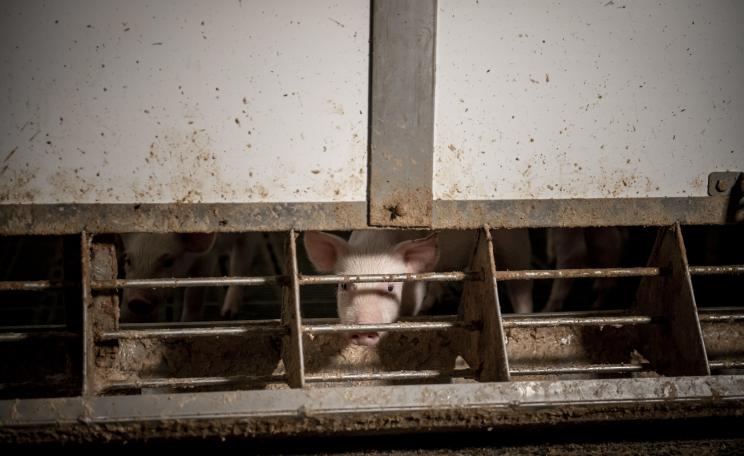Neuralink is a high-profile example of animals suffering and dying in vain, but this issue is by no means specific to that company or to the US.
A US Department of Agriculture probe into alleged animal welfare violations by Elon Musk’s Neuralink – a medical device company attempting to develop a brain implant to treat paralysis and other neurological conditions - was highlighted in a recent report by Reuters News Agency.
The company’s culture of urgency – exemplified by Musk’s aggressive messages to staff, including telling them to imagine they had a bomb strapped to their heads – has resulted in mistakes that harm and kill animals, including one incident where staff had to kill a pig to end her suffering after botching her surgery, according to the article. Neuralink has passed all USDA inspections of its facilities, according to public regulatory filings.
The message from Cruelty Free International to Musk and Neuralink is simple: if you want the Neuralink device to help human patients as soon as possible, ditch the animal tests and embrace non-animal methods.
Biology
Increasing evidence points towards animal tests impeding medical progress. Ninety-two percent of medicines entering human clinical trials never make it to market due, in part, to the inability of preclinical tests, including animal tests, to accurately predict human outcomes.
This phenomenon holds true for medical devices, where products in development often fall into a 'valley of death' instead of advancing to successful clinical use, despite positive results in animal tests.
The failure to translate from bench to bedside contributes to the drug development crisis – characterised by lead times of up to 15 years and research and development costs estimated to exceed $2 billion per drug – resulting in fewer safe, effective and affordable treatments for those who need them.
One of the reasons that animal tests frustrate the efficient development of treatments is that they are unreliable, lacking the ability to produce the same result on repeats of the same test and therefore creating a shaky foundation on which to base decisions about a drug or device’s safety and effectiveness.
Even if issues of reliability could be overcome, there are still fundamental differences between the biology of humans and other animals that erode the ability of animal tests to predict human outcomes.
Cures
In the absence of an animal species that naturally develops the disease in question, scientists often resort to genetically altering or surgically mutilating animals to recreate aspects of the condition, making the resulting animal model’s relevance to humans questionable.
Neuralink is a high-profile example of animals suffering and dying in vain, but this issue is by no means specific to that company or to the US.
Ordinarily, the poor translation from animals to humans means that the treatment simply fails to produce clinical benefit in humans or causes minor side effects that weren’t detected in animals.
On occasion, though, the effects are catastrophic – like when five human volunteers taking the experimental drug fialuridine died from liver damage, despite the drug appearing safe in tests on mice, rats, dogs and monkeys at doses hundreds of times higher than those administered.
The human relevance of animal tests is particularly low in the field of neurology.
One potential application of the Neuralink device is treating people with Alzheimer’s disease, but history is littered with examples of animals being ‘cured’ of an artificially-induced Alzheimer’s-like disease, only for the ‘cure’ to fail in human clinical trials. The same goes for stroke and muscular dystrophy, where, despite decades of intensive research using animals, no effective treatments or cures exist.
Simulated
Recent developments in science and technology have seen an explosion in cutting-edge research that advances knowledge without harming animals.
Cerebral organoids – ‘mini-brains’ derived from human cells and grown in the laboratory – are already used widely to understand human brain biology and disease and test the effectiveness of treatments.
Cerebral organoids derived from humans with Alzheimer’s spontaneously develop the hallmarks of the condition and are therefore likely to be a much better model for the disease than animals.
Earlier this year, in a paper that sounds more science fiction than science, Australian scientists described embedding human cell-derived neural networks in a simulated world mimicking the arcade game Pong. The networks were able to not only play the game but improve their performance in response to feedback.
Trials
Musk is often cited as a paradigm-disruptor, but his company’s adherence to the tired, old paradigm of testing on animals reveals a lack of imagination.
We understand that regulators typically require results from animal tests before permitting a drug or device to enter human clinical trials – something that Cruelty Free International scientists are striving to change by working with authorities to find safe routes to human trials that use fewer or no animals.
But there is no justification we can see for the seemingly excessive level of animal tests conducted by Neuralink. The company has experimented on and killed around 1,500 animals since 2018, according to the Reuters article.
Neuralink insists that it only conducts “confirmatory” tests on animals, and only when all other options have been exhausted. There is evidence to suggest that the company conducts exploratory surgeries and has actively tried to cover up this fact.
Reuters describes employees ordered to retroactively scrub the word “exploration” from study titles and avoid using it in future. Rival company Synchron, in contrast, already has its device in human clinical trials after having conducted tests on around eighty animals – still eighty too many, but a vast improvement on Neuralink’s 1,500 and counting.
Animal-free
Neuralink is a high-profile example of animals suffering and dying in vain, but this issue is by no means specific to that company or to the US. Around three million tests on animals are conducted each year in British laboratories, including at least 150,000 that we believe have a widely accepted non-animal alternative or are otherwise redundant.
This latter figure does not include the vast numbers of animal tests that are conducted for things like research into recreational drug use, duplicate existing work or cause extreme harm to the animals involved, let alone the million or more surplus animals who are bred and killed each year without even being used in an experiment.
For the sake of scientific progress and animals in laboratories, we need a plan to accelerate the transition to animal free research and testing, and that’s where Cruelty Free International’s #TargetZero campaign comes in.
In the UK, we’re calling on the UK Government to devise an ambitious strategy to bring experiments on animals to an end, led by a dedicated ministerial position. Compassionate UK citizens can support our campaign by writing to their MP.
The future of science is animal-free, and we urge Musk and others to embrace non-animal methods and usher in that future as quickly as possible.
This Author
Laura Alvarez is head of science policy and regulation at Cruelty Free International.




